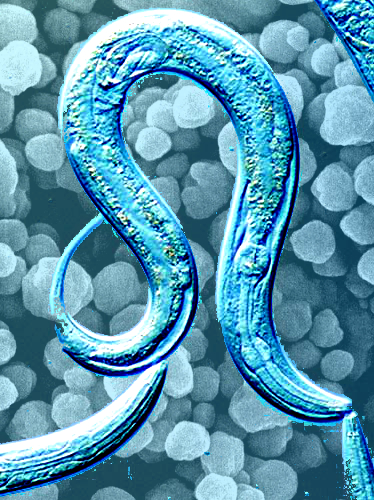Worms wrangled for tiny toxicity test
 The humble roundworm could become a pioneer of modern scientific safety, as part of tests to measure the toxicity of nanoparticles.
The humble roundworm could become a pioneer of modern scientific safety, as part of tests to measure the toxicity of nanoparticles.
Enigneers at Rice University in the US are using roundworms (Caenorhabditis elegans) to measure the effects of many types of nanoparticles not only on individual organisms, but also on entire populations.
“Nanoparticles are basically new materials, and we don't know much about what they will do to human health and the health of the ecosystem,” said Dr Qilin Li, an associate professor of civil and environmental engineering and of materials science and nanoengineering.
“It's important that we understand we're not putting anything toxic into the environment or into consumer products.
“[But] the question is; how much cost can we bear?” she asked.
Due to the large variety of nanomaterials being produced at high speed and at such a large scale, there is “an urgent need for high-throughput screening techniques to prioritize which to study more extensively,” Li said.
The Rice researchers tested 20 types of nanoparticles and determined that five, including the carbon-60 molecules (“buckyballs”) discovered at the university in 1985, showed little to no toxicity.
Others were moderately or highly toxic to the worms, with the particles' effects on their health visible for several generations.
Roundworms were used because they provide a useful gauge of the effects on individuals and communities, across generations.
They are also very cheap and available in abundance.
C. elegans has a life cycle of about three days, and since each can produce many offspring, a population that started at 50 would number more than 10,000 after a week.
Materials for each nanoparticle assay, including the worms, the bacteria they consumed and the culture media, cost about 50 cents, researcher Weiwei Zhong said.
The researchers used four tests to see how worms react to nanoparticles: fitness, movement, growth and lifespan.
The most sensitive gauge of toxicity was 'fitness'. In this test, the researchers mixed the nanoparticles in solutions with the bacteria that worms consume.
“If the worms' health is affected by the nanoparticles, they reproduce less and eat less,” Zhong said.
“In the fitness assay, we monitor the worms for a week. That is long enough for us to monitor toxicity effects accumulated through three generations of worms.”
The researchers studied samples of three classes of nanoparticles - metal, metal oxides and carbon-based – and examined the toxicity of each nanoparticle at four concentrations.
“We did not do polymeric nanoparticles because the type of polymers you can possibly have is endless,” Li explained.
The results showed C-60 fullerenes, fullerol (a fullerene derivative), titanium dioxide, titanium dioxide-decorated nanotubes and cerium dioxide were the least damaging to worm populations.
The ‘fitness’ tests confirmed there was a dose-dependent level of toxicity for carbon black, single- and multiwalled carbon nanotubes, graphene, graphene oxide, gold nanoparticles and fumed silicon dioxide.
The size and shape of the particle played a role too.
While amine-functionalised multiwalled nanotubes proved highly toxic, hydroxylated nanotubes had the least toxicity, with significant differences in fitness, body length and lifespan.
The team developed its own software – dubbed ‘QuantWorm’ – to perform their analysis, and say that the method could be useful as a rapid way for companies to narrow the range of nanoparticles they wish to put through more expensive, dedicated toxicology testing.
The results were published by the American Chemical Society journal Environmental Sciences and Technology.







 Print
Print